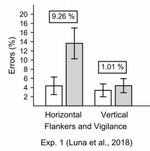Abstract
Perceptual grouping leads to interference when target and distractors are integrated within the same percept. Cognitive control allows breaking this automatic tendency by goal-directed mechanisms or by physical features of stimuli that help to segregate the target from distractors. In three experiments, participants had to respond to the left-right direction of a central arrow, flanked by two arrows on each side. Sometimes, instructions requested to also stay vigilant for detecting an infrequent vertical/horizontal displacement of the target, thus loading working memory. While it has been usually shown that concurrent working memory load hinders target selection, the present research provides evidence that interference may either increase or decrease depending on whether dual tasking draws attention to the grouping (horizontal displacement) or to an orthogonal dimension (vertical displacement), revealing counter-intuitive benefits of working memory load.
